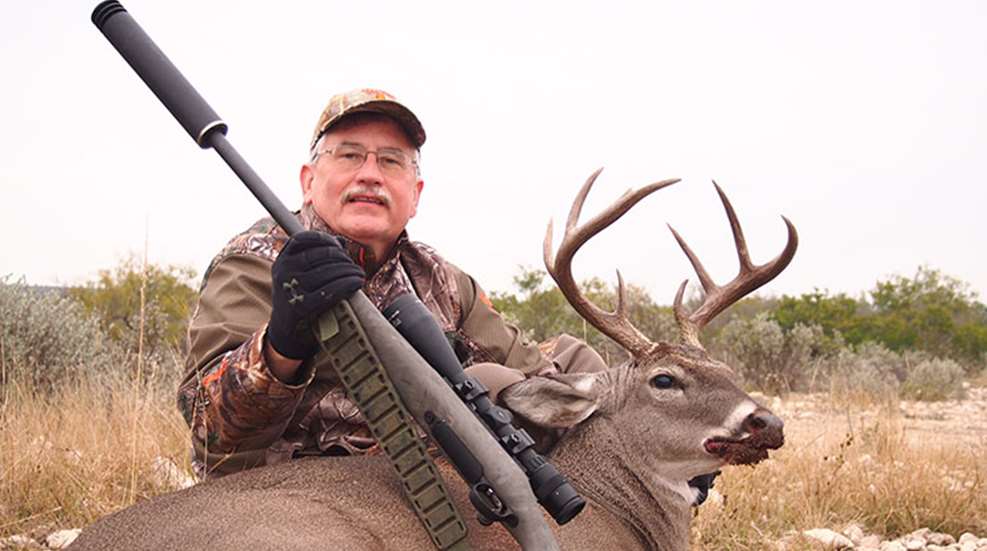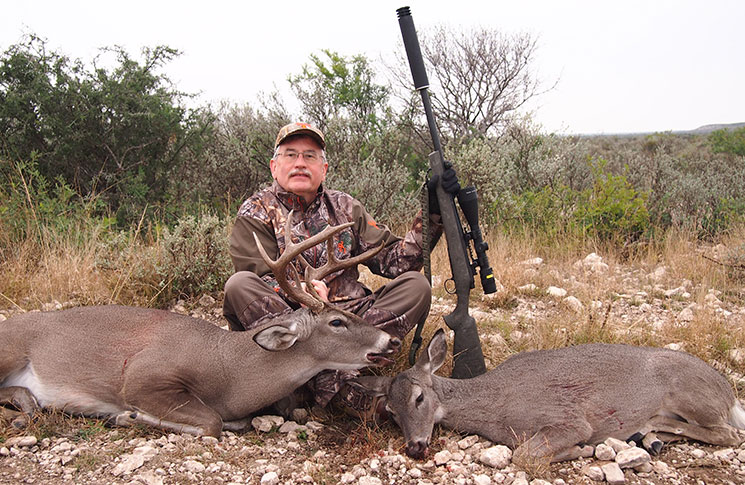
We bumped along the stony road on our way to that morning’s South Texas hunting stand, the pre-dawn sky above us shot full of tiny stars so bright I could see dark clumps of mesquite scattered over the rocky soil, the fans of prickly pear cactus and the winding, dry washes littered with small boulders.
We sat in the open, raised back end of a small 4WD Suzuki, the air in our faces surprisingly cold for Texas. Yes, it was December, but we were less than 20 miles from the Mexican border near Del Rio. The chilly air was better than coffee, though, which got me excited, so I scanned the shadowy landscape for a hog or a deer, a sign we were in for a good day of hunting.
I was in South Texas with Darren Jones, a good friend who is also the marketing manager for suppressor manufacturer SilencerCo. Several months earlier, I’d mentioned to Jones that while I’d fired many suppressed firearms, I had never taken an animal with one. Jones’ mouth opened in surprise, his thick, dark eyebrows nearly touching as his eyes just about squinted shut.
“Brother, we are going to have to get you on a suppressed hunt, ASAP!” he said.
“Well, sure, but …” I began.
“Dude, we can’t let this stand!” Jones said, in that emphatic way he has as a former Marine Corps officer with several Middle East tours who is used to ordering around the uninitiated. “Hunting with a suppressor? It’s a very different deal. You will see!”
Sir, yes, sir! I wanted to bark back at him. But I thought better of it.
Jones was as good as his word, and within a few weeks he’d arranged this hunt for deer and hogs with Double T Outfitters of Del Rio. We were hunting a 16,000-acre ranch that held a few cattle, hundreds of white and gray sheep, and all kinds of whitetails.
Also fueling this hunt was the fact that Jones’ employer, SilencerCo of West Valley City, Utah, had just released a suppressor for a shotgun, the Salvo 12. I’d used the Salvo 12 at the shooting range, and even knocked down a few clay pigeons with it. Now, I was going to see how the Salvo 12 worked in the field, on a hunt, in this case hoping for a hog to show up.
Our ground blind was tucked under a spreading mesquite tree and next to a tall stand of cactus. Jones and I ducked into the blind and got ready. I was using a 12-gauge Benelli M2, and was loaded for hog—literally—with Winchester’s Razor Boar XT 2¾-inch shells, each one holding eight pellets of OO buckshot. A game feeder sat some 30 yards ahead of us, the tapered end of the feed bin rising into the gray sky. Our guides had spotted some hog tracks underneath the feeder a day before.
It didn’t take long for the Texas sun to rise and begin to warm the blind. By the time it did and I was getting dozy from the warmth, Jones bumped my forearm with his hand and nodded ahead.
Through the green-and-yellowing brush, two does angled in, found a patch of grass and stopped to eat about 25 yards ahead of us. Jones raised his eyebrows at me, asking, “You want?”
I did. Our outfitter’s ranch was in the state’s deer management program and they needed to take several dozen does out of the local herd. Hold out for a good buck, our guide had said, but feel free to bag some does, too.
I eased the Salvo-tipped shotgun barrel out of the blind’s window, and waited for the larger of the two does to present a broadside shot. She did. I snapped off the safety and she raised her head, apparently having heard the snick of metal releasing metal. I fired.
The doe collapsed where she stood. The other doe jumped, unsure what had just happened. Even with a suppressor, the shotgun made noise, of course. Yet what would otherwise be a loud and scary KA-boom! that gets wild game sprinting is more muffled and spread out. The second doe knew something was up, though, and trotted away.
We stepped out of the blind to retrieve the doe, and a small spike buck suddenly popped out of the brush, looked us over, turned and ran.
Once we got to our ranch, Jones and I spent the last hour of daylight practicing with the shotgun and several rifles he’d brought, each of them fitted with a SilencerCo suppressor. I used the Benelli first, made sure it was patterning correctly at 25 and 30 yards with the Winchester Razor Boar and various No. 4 and No. 5 shot loads.
Then we switched over to rifles, including a .308 caliber Remington 700 bolt action tipped with a SilencerCo Harvester Big Bore suppressor.
It’s a strange thing for me, firing a shotgun or rifle without hearing protection. When hunting, I usually use earplugs. I keep one plug in my left ear, and have the other plug—on a string—ready to go in just before I take a shot. It can be a hassle to get in plug No. 2 before I take the shot. But, I like my hearing. And while I am sure years of shooting, rock music and all-round living have damaged it somewhat, my hearing’s still pretty much intact. So to spend an hour firing different firearms with no shouting at each other between shots and no sore ear canals from plugs when we were done was strange. But very liberating.
I thought I was going to get my South Texas buck the second morning. Jones and I were in a box blind about 15 feet in the air, perched above rolling, sage brush-covered hills. As the light grew, we saw whitetails here and there, meandering through the brush and then up the road behind us we had drove in on.
Right at good shooting light, the buck appeared—a nice 8 with a stout body. He came up the road behind us, closer and closer, and I had just turned and gotten into a better shooting position when he put his nose to the ground, halted for a moment then sprinted into the brush. A moment later, we saw a doe sprinting and twisting through the mesquite, the buck on her track.
“Hot doe,” Jones said.
“Hotter buck” I replied, as we watched the two disappear over a small hill.
Later, 50 or so white sheep appeared a couple hundred yards in front of the blind, and cut through the dull olive-colored brush like a wedge of moving snow, pushing several does ahead of them. That pretty much killed any deer activity for an hour.
So when a group of three does eventually showed up about 100 yards in front of us, I figured it was as good as the morning would get. I laid the reticle of the Trijicon AccuPoint on the shoulder of the middle doe and squeezed the trigger. She jerked, staggered, ran to the lip of a depression and toppled over into the sage.
The two remaining does looked around, trying to figure out what happened. When I chambered a new round, the spent .308 brass hit the metal floor of the box blind with a loud ping. Then and only then did the other two does run for cover.
By the third and last morning of our hunt I had yet to take my “management buck,” the definition of which changes with outfitters and sometimes day by day. Generally, it’s a buck with eight points or less, a nice rack but unlikely to get any bigger. It could also be an older buck in his decline.
First, though, the teaser: A buck carrying a rack with 11 points that spread well outside his ears and a thick, muscular body suddenly appeared at 150 yards and presented a perfect broadside shot.
“Only if you want to pay the trophy fee,” Jones said, grinning.
“Damn, darn, damn …”
Then we saw him several hundred yards away, just peeking his head out of the brush alongside the rough road we’d come down earlier that morning. Jones and I put our binos on him, checking and re-checking with each other until we were sure. Good body, eight points, a bump on one beam, maybe 41/2 years old—a shooter management buck.
Then he began running after a doe, veered off to the side of the road, taking with him a smallish 6-pointer trying to get in on the action. We saw flashes of hide and horn through the brush, but the three deer headed straight away from us. I sat back in my chair, wondering if I was going to have to settle for another doe.
It wasn’t 10 minutes later when I caught some movement to my left, and saw a buck not 50 yards away, his nose to a rectangular concrete watering tank.
“Hey,” I whispered, to Jones. “What about this guy?”
“That’s him,” Jones said, meaning the buck we’d seen running the doe. “Shoot!”
I eased the rifle barrel and suppressor through the window. I lined up the reticle on his shoulder then dropped it down a couple inches, figuring at this near distance the shot would actually go high. I squeezed the trigger and the Hornady Superformance 165-grain GMX dropped my buck right there. On a slight rise a hundred years away, two does and a spike buck looked around for a few seconds then went back to feeding.
“He’s a bump nine!” Jones proclaimed a couple minutes later as we stood next to the buck. “Nice!”
He’d weigh in at 180 pounds. One nice South Texas buck, two does, no hearing protection and no ringing in my ears; it was a fine hunt all around.
The Salvo 12
Let’s be upfront about this: the Salvo 12 shotgun suppressor looks ungainly as heck. And it does take up some extra room in a shooting blind. But it actually doesn’t hinder swinging the shotgun (with some practice), reduces recoil by a good 20 percent, I would guess, and in the full-length version allows you to shoot without the need for hearing protection.
The “full-length” Salvo 12 is 12 inches long, and the sound level is brought down to 136.8 decibels (dB) at the muzzle, using field and trap loads—well below the 140 dB hearing-safe threshold set by OSHA. Kits can be purchased to reduce the suppressor length to 10, 8 and 6 inches. (Obviously, decibel suppressor is decreased as the salvo is made shorter.) The Salvo is secured to the end of the barrel via a screw-in mount that uses the standard factory choke tube threads.
The Salvo 12 can handle all wadded pellet loads, as well as buckshot and slugs. However, there are some shell velocity restrictions, depending on the length of barrels used, and under no circumstances can you fire 31/2-inch shells through the Salvo.
My recommendation: if you use the Salvo 12 for turkey, hog or deer hunting, put an optic on your shotgun or mount a set of raised open sights on it. A standard front bead works fine for wingshooting, but it can be hard to find for more stationary shots.






































